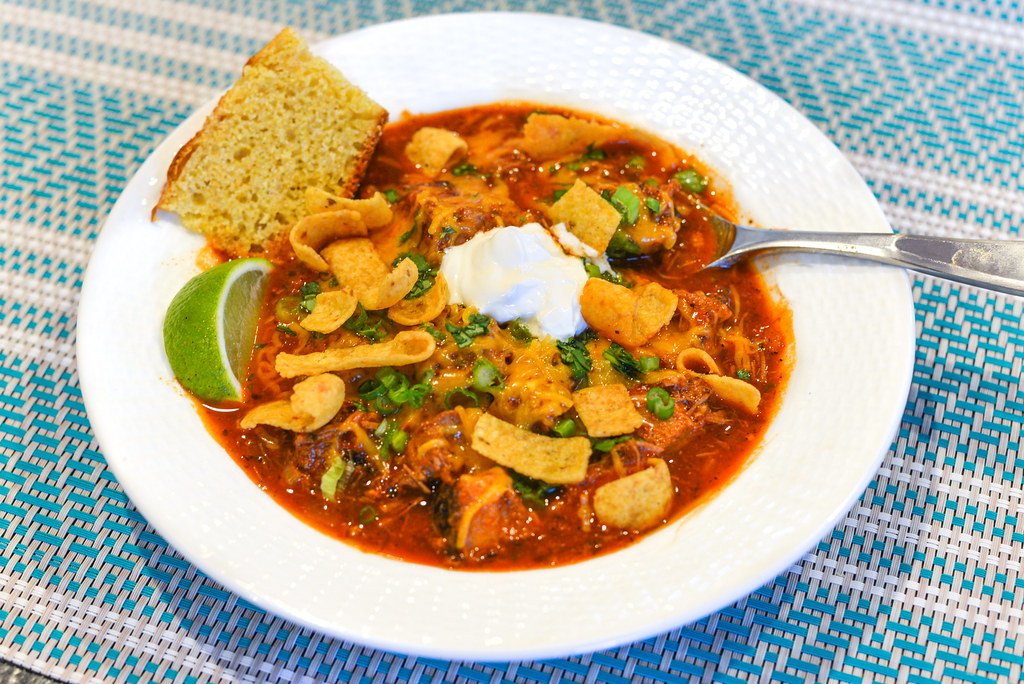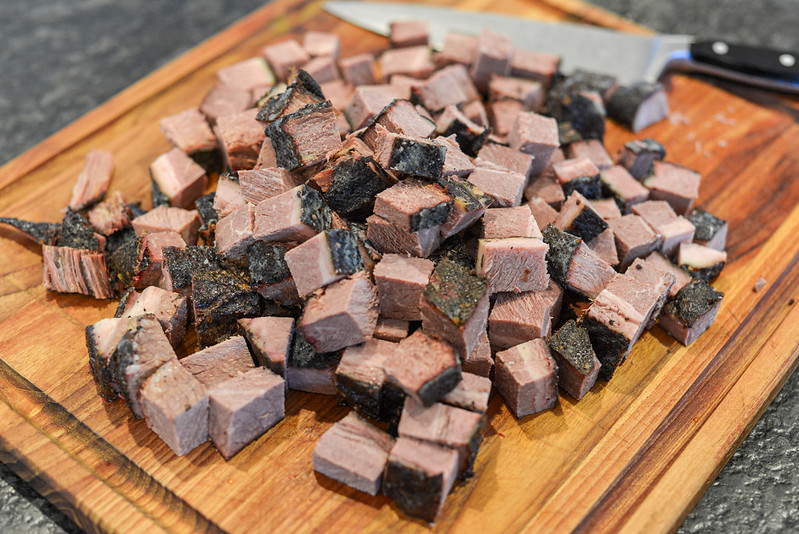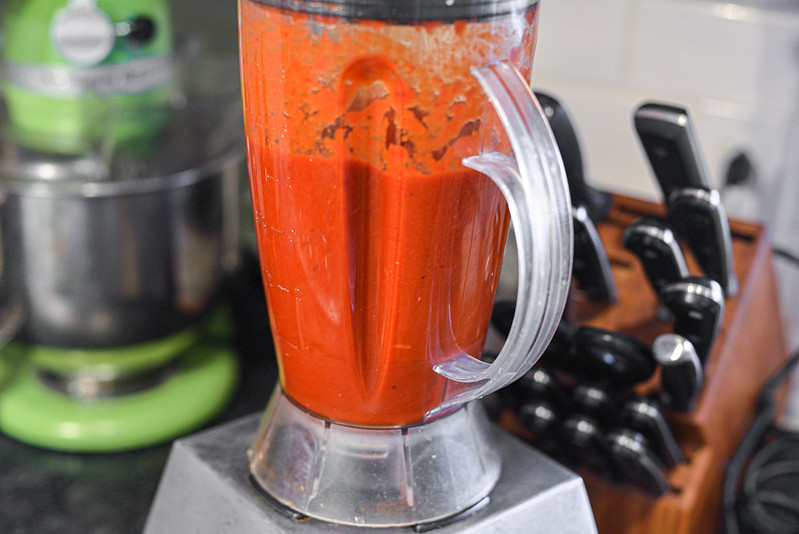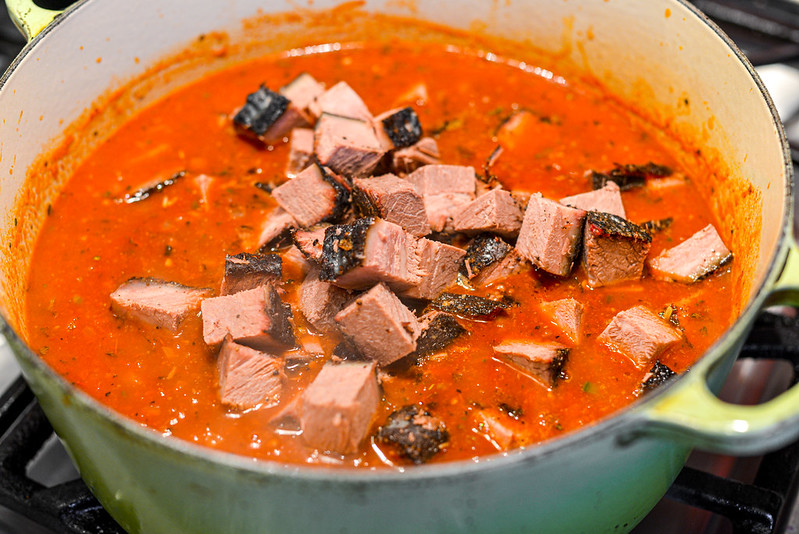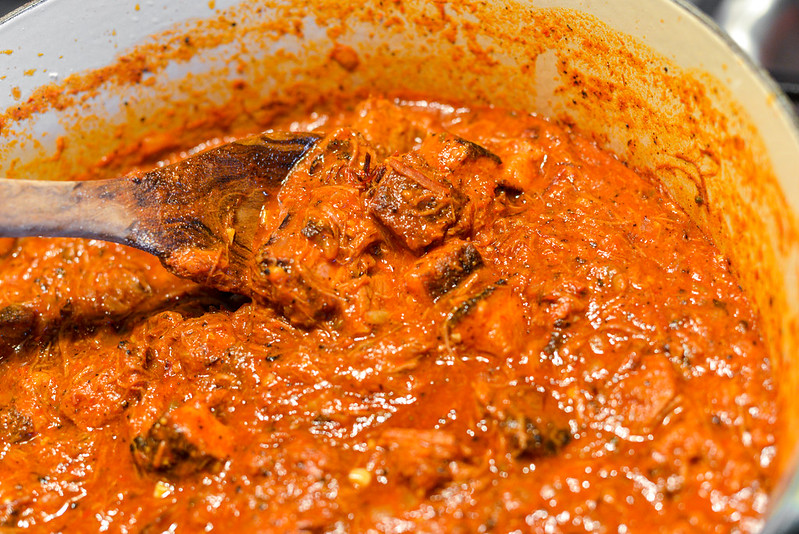Smoked Brisket Chili
Back in July I really, really wanted some brisket for the 4th, so I smoked up a monster 17 pound slab of beef, but due the pandemic, I didn't have my usual posse of Meatwavers to help me finish the thing and my wife and I only put a small dent in the glorious piece of meat that came out of the smoker that day. While the absence of sharing of food has been the hardest thing for me to cope with in the past year, I saw this as an opportunity to finally make a plethora of leftover brisket recipes—something this site lacked because brisket is not something I usually have a lot of leftovers of. This had led to some excellent things like brisket waffle fries and brisket cheesesteaks, but the last recipe I worked on ended up being the best—smoked brisket chili.
I knew I wanted to make a chili out of a large chunk of that brisket, so I froze an entire section that was about three pounds in weight, which was mostly the flat, but had a bit of the point attached too. I was waiting for the right moment to cook this chili, and that arrived on Christmas day when my brother-in-law and his wife were going to stop by. That day was incredibly cold, and since we weren't doing indoor hangs, we decided to build a giant fire for warmth outside and a spicy bowl of chili felt like the perfect compliment for that setting.
At this point in my life, I'm pretty well versed in my chili making, which tends to lean towards all-meat Texas style, but with some touches I personally like. To start off, I always go for whole dried chilis that I toast until fragrant. I don't sweat the exact chilis that go into the mix, but I do like having a combination to hit various peppery notes. This time around I used mild New Mexicans, fruity anchos, lightly smoky guajillos, and spicy arbols.
Once those were all nice a toasty, I transferred them to a bowl, covered them with boiling water, and let them steep. In my early days, I would grind the chilies into a powder, but I've come to prefer steeping them because once they're tender, they more effectively break down and become a seamless sauce when blended.
While those steeped, I prepped the brisket, which I had defrosted under running cold water first. It was still pretty cold, which was good because it made it easier to slice into cubes roughly one and a half inches in size. I went for these relatively big chunks because I wanted some whole pieces of meat in the end, which I find preferable to meat that has completely broken down and is more mush than anything.
After fifteen minutes of steeping, I transferred the chilies to a blender and added in a cup of the steeping liquid too, reserving the rest in case I needed to use it thin out the chili at all while cooking. I added to that a chipotle in adobo, with some extra adobo sauce, and a can of fire roasted tomatoes. Texas-style chili recipes don't always go for the tomatoes, but I'm fan of using them because they create a much more attractive color as well as add a nice fruitiness and acidity that matches up well with the peppers.
Next step was to lightly brown a whole diced onion over medium-high heat and then add in the rest of the seasonings, which included jalapeño, garlic, cumin, and oregano.
I then added in the chili puree, brisket cubes, and a quart of beef stock. That last part I think is important because unlike a normal chili that simmers the beef for hours in the liquid, this cooked brisket really just needed to heat up, so it doesn't have the same opportunity to impart big beefy flavor to what would normally be water or chicken stock. I thought the beef stock was so important that I didn't use the canned stuff either, I went for my homemade, gelatin rich stock that I save for the recipes I care about most.
If you're making this, you'll realize there's far less liquid than a normal chili recipe, and that's because a long cook isn't required where liquid will evaporate and condense down. I actually deemed this chili down about an hour into cooking when the beef cubes were completely tender and some had started to break down, giving a good contrast of meaty textures. The final step was just stirring in some lime juice followed by masa harina, which I added in a tablespoon at a time until the chili reached my desired thickness.
I actually ate my bowl before we had to go sit out in the cold because of the need to photograph it first. I took photos during various stages of topping additions, and while once it was fully loaded you couldn't actually see the chili as well, it didn't look right to me until I had all that cheese, scallions, cilantro, sour cream, and, most importantly, Fritos, on top. I worried about how well using already fully cooked beef would work in a chili, but this ended up being my favorite red chili I've ever made! Rather than being a detriment, the brisket was way more flavorful than using raw beef thanks to its strong smoky character and darkened, peppery bark, which were traits well suited to go with a such a vibrant and spicy sauce whose acidity helped keep the chili from tasting overly rich. That made it easy to eat a whole bowl and then go back for seconds, and I luckily still had some leftovers at the end of the day that let me continue to enjoy the chili a couple more times before it was gone. And with that, my story of a mighty 17 pound brisket for two people finally comes to a close and while I certainly hope this year I'll be able to have friends and family over the next time I smoke one up, if that can't happen, at least I can find solace knowing that I can make another one and have it deliver joy over and over again throughout the year like this brisket did in 2020.
